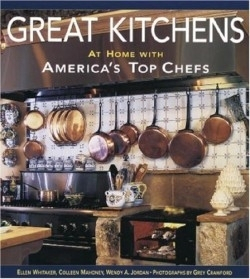Great Kitchens
At Home with America's Top Chefs
Chefs, despite making their livings cooking, like to leave work and have all the same comforts and perks in their home kitchens. While some of these perks may be over-the-top for the average home kitchen, many of them provide good stepping stones for ideas of what makes a useful home kitchen.
The chefs? tastes run from the thoroughly modern, such as Georges Perrier’s (Le Bec-Fin) white-and-granite Philadephia kitchen, to completely rustic, like Jean-Pierre Moullé’s (Chez Panisse) 300-year-old Bordeaux farmhouse.
One thing they all have in common, however, are islands. Chefs need counter space, they agree, and islands—some with built-in ranges, some that move—are the perfect answer. Anne Quatrano of Atlanta’s Bacchanalia says of her “floating tables”: “Every kitchen should have an island, but these are flexible as well.” Her tables came with under-counter storage racks for pots and pans and she added maple butcher-block tops.
Big sinks are another commonality. Chefs like sinks that are deep enough and faucets that are high enough to accommodate large pots and pans. Charles Dale, owner of Renaissance in Aspen, Colorado, says, “Always buy your sink based on what you’re going to do with it.”
Most of these chefs bought homes that they liked, then fixed up the kitchens to their own standards. Some of the more interesting comments in the book are chefs saying what they would do differently. Mary Sue Milliken, co-owner of Border Grill and Ciudad in Santa Monica, California, said she wishes she?d installed an under-mounted sink with the counter extended over the edge of the sink to make it easier to wipe the counters clean. One of the chefs with young children, has a kitchen open to the rest of the house so she can keep an eye on things while she’s cooking.
There are good ideas for easy clean-up, too, such as fast (three minute cycle) dishwashers that are also extremely quiet and rubbing hardwood counters with mineral oil once a week to keep them from getting dried out or mildewed.
Equipment types are detailed, whether it’s a huge range or a Sub Zero refrigerator, and the chefs explain why they chose that brand and model. Many of the chefs have large collections of cooking utensils, irregular shaped dishes and other oddities they’ve scavenged over the years, so they have incorporated storage space not only for the kitchen items they use, but to show off as well. There are several different kinds of cupboards, ranging from all white and enclosed to ripple-glass front to wide open.
Some of the chefs? kitchen features are costly for the average home cook, such as the built-in bread warmers, built-in plate warmers and the 160 halogen bulbs in Georges Perrier’s Philadelphia home. They’re fun to read about, however, and could be useful in a scaled-down manner.
Twenty-six chefs? kitchens are profiled in all. Grey Crawford’s color photographs are nice for showing color choices and details; each kitchen’s layout is detailed in a line drawing.
Reviewed by
Jodee Taylor
Disclosure: This article is not an endorsement, but a review. The publisher of this book provided free copies of the book to have their book reviewed by a professional reviewer. No fee was paid by the publisher for this review. Foreword Reviews only recommends books that we love. Foreword Magazine, Inc. is disclosing this in accordance with the Federal Trade Commission’s 16 CFR, Part 255.

